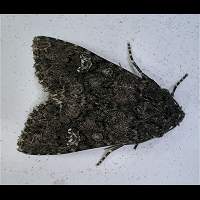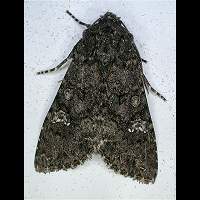Cabbage Moth Mamestra brassicae
The Cabbage Moth may present you with some obstacles trying to identify it. It is highly variable and there are a number of similar species. In the picture is a very dark and badly marked animal. Luckily many are lighter and are marked more clearly. The ground colour is always greyish to blackish. The kidney spot has a chalky white outline, the round spot has not. In the similar White Colon both spots are outlined dirty whitish. Another look-a-like is Mniotype adusta, a non-British species, but sometimes encountered on the continent. It always has a brownish basic colour opposed to the greyish of the Cabbage Moth. The Nutmeg is also similar, but it has a larger kidneymark. Some Apamea-species, such as the Crescent Striped, are also very similar, especially when not well marked. The best way to tell the Cabbage Moth apart from all other species is to catch it and look at the front leg. The Cabbage Moth is the only species having a small bended spur on the tibia of the front leg. The species is extremely variable in size as well, for the wingspan runs from 34mm to 50mm.
The eggs are deposited in groups in summer and early autumn on the underside of leaves of the foodplant. They may hatch very quickly, sometimes the caterpillars do crawl about only 8 days after the eggs having been laid. The caterpillars feed during the night and hide near or even in the ground during the day. They also live inside the foodplant when this is made up of many leaves folded together. Most caterpillars pupate in autumn in thin cocoons in the earth. Some however overwinter while being in the larval stage. Young caterpillars are green with yellow rings between the segments. Older caterpillars usually are brownish on top and greenish underneath. The spriracula are white and outlined with a black circle. Just below the spiracula runs a white, yellow or orange line. On the back are black two rows of black dots, joining at segment 11 into one black blur. The head is yellowish brown to dark brown with some light markings. The caterpillar grows to a length of some 45mm. The larvae are sometimes found in trees, oak and birch mainly. They usually are found in cabbage, sometimes in numbers. The species is very harmful in cabbage, for it will eat the plant from the inside. This way it takes some time before it is discovered. During which time the crops may be completely ruined. The Cabbage Moth may be accompanied by other caterpillars on cabbage, such as the larvae of the Great White, the Small White, the Silver Y and the rare Pearly Underwing.
The Cabbage Moth has two or maybe even three generations and is on the wing from May to October. An occasional specimen may be seen in other months. It flies by night only and eagerly visits flowers in gardens. Is also attracted to light and sugar. When caught at night it turns out to be a willing photographer's model next day. However useless as such during darkness, when it turns out to be extremely restless. Because the caterpillars prefer to feed on cabbage this is a species found mainly in cultivated areas: gardens, farmland etc. A very common species all over Britain and Ireland, but getting less widely spread northwards. Very common on the continent as well.
The Cabbage Moth may present you with some obstacles trying to identify it. It is highly variable and there are a number of similar species. In the picture is a very dark and badly marked animal. Luckily many are lighter and are marked more clearly. The ground colour is always greyish to blackish. The kidney spot has a chalky white outline, the round spot has not. In the similar White Colon both spots are outlined dirty whitish. Another look-a-like is Mniotype adusta, a non-British species, but sometimes encountered on the continent. It always has a brownish basic colour opposed to the greyish of the Cabbage Moth. The Nutmeg is also similar, but it has a larger kidneymark. Some Apamea-species, such as the Crescent Striped, are also very similar, especially when not well marked. The best way to tell the Cabbage Moth apart from all other species is to catch it and look at the front leg. The Cabbage Moth is the only species having a small bended spur on the tibia of the front leg. The species is extremely variable in size as well, for the wingspan runs from 34mm to 50mm.
The eggs are deposited in groups in summer and early autumn on the underside of leaves of the foodplant. They may hatch very quickly, sometimes the caterpillars do crawl about only 8 days after the eggs having been laid. The caterpillars feed during the night and hide near or even in the ground during the day. They also live inside the foodplant when this is made up of many leaves folded together. Most caterpillars pupate in autumn in thin cocoons in the earth. Some however overwinter while being in the larval stage. Young caterpillars are green with yellow rings between the segments. Older caterpillars usually are brownish on top and greenish underneath. The spriracula are white and outlined with a black circle. Just below the spiracula runs a white, yellow or orange line. On the back are black two rows of black dots, joining at segment 11 into one black blur. The head is yellowish brown to dark brown with some light markings. The caterpillar grows to a length of some 45mm. The larvae are sometimes found in trees, oak and birch mainly. They usually are found in cabbage, sometimes in numbers. The species is very harmful in cabbage, for it will eat the plant from the inside. This way it takes some time before it is discovered. During which time the crops may be completely ruined. The Cabbage Moth may be accompanied by other caterpillars on cabbage, such as the larvae of the Great White, the Small White, the Silver Y and the rare Pearly Underwing.
The Cabbage Moth has two or maybe even three generations and is on the wing from May to October. An occasional specimen may be seen in other months. It flies by night only and eagerly visits flowers in gardens. Is also attracted to light and sugar. When caught at night it turns out to be a willing photographer's model next day. However useless as such during darkness, when it turns out to be extremely restless. Because the caterpillars prefer to feed on cabbage this is a species found mainly in cultivated areas: gardens, farmland etc. A very common species all over Britain and Ireland, but getting less widely spread northwards. Very common on the continent as well.





